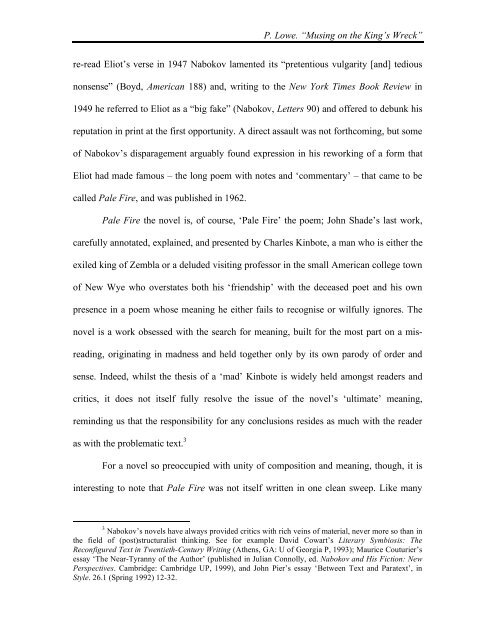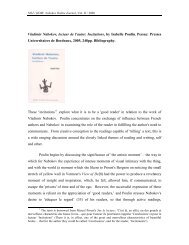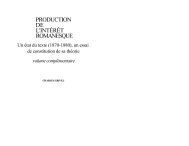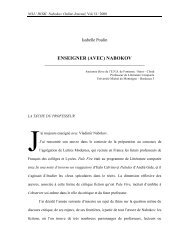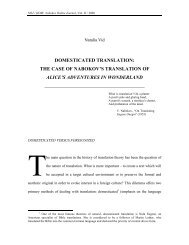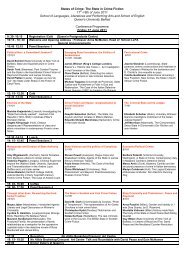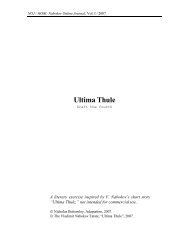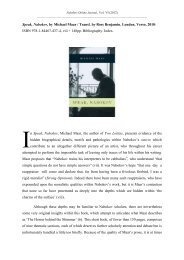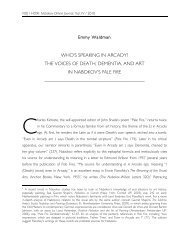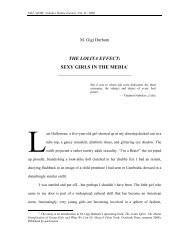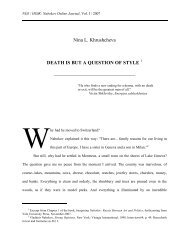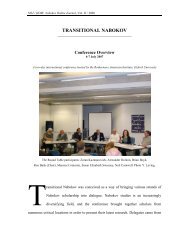musing upon the king's wreck - Electronic Text Centre
musing upon the king's wreck - Electronic Text Centre
musing upon the king's wreck - Electronic Text Centre
Create successful ePaper yourself
Turn your PDF publications into a flip-book with our unique Google optimized e-Paper software.
P. Lowe. “Musing on <strong>the</strong> King’s Wreck”<br />
re-read Eliot’s verse in 1947 Nabokov lamented its “pretentious vulgarity [and] tedious<br />
nonsense” (Boyd, American 188) and, writing to <strong>the</strong> New York Times Book Review in<br />
1949 he referred to Eliot as a “big fake” (Nabokov, Letters 90) and offered to debunk his<br />
reputation in print at <strong>the</strong> first opportunity. A direct assault was not forthcoming, but some<br />
of Nabokov’s disparagement arguably found expression in his reworking of a form that<br />
Eliot had made famous – <strong>the</strong> long poem with notes and ‘commentary’ – that came to be<br />
called Pale Fire, and was published in 1962.<br />
Pale Fire <strong>the</strong> novel is, of course, ‘Pale Fire’ <strong>the</strong> poem; John Shade’s last work,<br />
carefully annotated, explained, and presented by Charles Kinbote, a man who is ei<strong>the</strong>r <strong>the</strong><br />
exiled king of Zembla or a deluded visiting professor in <strong>the</strong> small American college town<br />
of New Wye who overstates both his ‘friendship’ with <strong>the</strong> deceased poet and his own<br />
presence in a poem whose meaning he ei<strong>the</strong>r fails to recognise or wilfully ignores. The<br />
novel is a work obsessed with <strong>the</strong> search for meaning, built for <strong>the</strong> most part on a mis-<br />
reading, originating in madness and held toge<strong>the</strong>r only by its own parody of order and<br />
sense. Indeed, whilst <strong>the</strong> <strong>the</strong>sis of a ‘mad’ Kinbote is widely held amongst readers and<br />
critics, it does not itself fully resolve <strong>the</strong> issue of <strong>the</strong> novel’s ‘ultimate’ meaning,<br />
reminding us that <strong>the</strong> responsibility for any conclusions resides as much with <strong>the</strong> reader<br />
as with <strong>the</strong> problematic text. 3<br />
For a novel so preoccupied with unity of composition and meaning, though, it is<br />
interesting to note that Pale Fire was not itself written in one clean sweep. Like many<br />
3 Nabokov’s novels have always provided critics with rich veins of material, never more so than in<br />
<strong>the</strong> field of (post)structuralist thinking. See for example David Cowart’s Literary Symbiosis: The<br />
Reconfigured <strong>Text</strong> in Twentieth-Century Writing (A<strong>the</strong>ns, GA: U of Georgia P, 1993); Maurice Couturier’s<br />
essay ‘The Near-Tyranny of <strong>the</strong> Author’ (published in Julian Connolly, ed. Nabokov and His Fiction: New<br />
Perspectives. Cambridge: Cambridge UP, 1999), and John Pier’s essay ‘Between <strong>Text</strong> and Paratext’, in<br />
Style. 26.1 (Spring 1992) 12-32.


